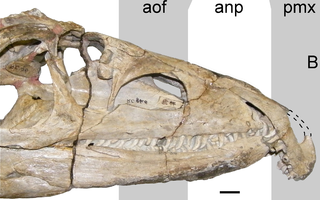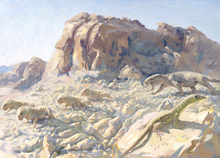
Archosauriformes is a clade of diapsid reptiles encompassing archosaurs and some of their close relatives. It was defined by Jacques Gauthier (1994) as the clade stemming from the last common ancestor of Proterosuchidae and Archosauria. Phil Senter (2005) defined it as the most exclusive clade containing Proterosuchus and Archosauria. Archosauriforms are a branch of archosauromorphs which originated in the Late Permian and persist to the present day as the two surviving archosaur groups: crocodilians and birds.

Archosauromorpha is a clade of diapsid reptiles containing all reptiles more closely related to archosaurs rather than lepidosaurs. Archosauromorphs first appeared during the late Middle Permian or Late Permian, though they became much more common and diverse during the Triassic period.

Tanystropheus is an extinct genus of archosauromorph reptile which lived during the Triassic Period in Europe, Asia, and North America. It is recognisable by its extremely elongated neck, longer than the torso and tail combined. The neck was composed of 13 vertebrae strengthened by extensive cervical ribs. Tanystropheus is one of the most well-described non-archosauriform archosauromorphs, known from numerous fossils, including nearly complete skeletons. Some species within the genus may have reached a total length of 6 meters (20 ft), making Tanystropheus the longest non-archosauriform archosauromorph as well. Tanystropheus is the namesake of the family Tanystropheidae, a clade collecting many long-necked Triassic archosauromorphs previously described as "protorosaurs" or "prolacertiforms".

Protorosaurus is an extinct genus of reptile. Members of the genus lived during the late Permian period in what is now Germany and Great Britain. Once believed to have been an ancestor to lizards, Protorosaurus is now known to be one of the oldest and most primitive members of Archosauromorpha, the group that would eventually lead to archosaurs such as crocodilians and dinosaurs.

Teleocrater is a genus of avemetatarsalian archosaur from the Middle Triassic Manda Formation of Tanzania. The name was coined by English paleontologist Alan Charig in his 1956 doctoral dissertation, but was only formally published in 2017 by Sterling Nesbitt and colleagues. The genus contains the type and only species T. rhadinus. Uncertainty over the affinities of Teleocrater have persisted since Charig's initial publication; they were not resolved until Nesbitt et al. performed a phylogenetic analysis. They found that Teleocrater is most closely related to the similarly enigmatic Yarasuchus, Dongusuchus, and Spondylosoma in a group that was named the Aphanosauria. Aphanosauria was found to be the sister group of the Ornithodira, the group containing dinosaurs and pterosaurs.

Proterosuchus is an extinct genus of archosauriform reptiles that lived during the Early Triassic. It contains three valid species: the type species P. fergusi and the referred species P. alexanderi and P. goweri. All three species lived in what is now South Africa. The genus was named in 1903 by the South African paleontologist Robert Broom. The genus Chasmatosaurus is a junior synonym of Proterosuchus.

Drepanosaurs are a group of extinct reptiles that lived between the Carnian and Rhaetian stages of the late Triassic Period, approximately between 230 and 210 million years ago. The various species of drepanosaurid were characterized by specialized grasping limbs and often prehensile tails, adaptions for arboreal (tree-dwelling) and fossorial (digging) lifestyles, with some having also been suggested to be aquatic. Fossils of drepanosaurs have been found in Arizona, New Mexico, New Jersey, Utah, England, and northern Italy. The name is taken from the family's namesake genus Drepanosaurus, which means "sickle lizard," a reference to their strongly curved claws.

Acerosodontosaurus is an extinct genus of neodiapsid reptiles that lived during the Late Permian of Madagascar. The only species of Acerosodontosaurus, A. piveteaui, is known from a natural mold of a single partial skeleton including a crushed skull and part of the body and limbs. The fossil was discovered in deposits of the Lower Sakamena Formation. Based on skeletal characteristics, it has been suggested that Acerosodontosaurus individuals were at least partially aquatic.
Vonhuenia is an extinct genus of proterosuchid, a basal archosauriform from the Early Triassic of Russia. Fossils have been found in the Vokhminskaya Formation, along the Vetluga River that are Induan in age, making Vonhuenia one of the earliest archosauriforms.

Jesairosaurus is an extinct genus of early archosauromorph reptile known from the Illizi Province of Algeria. It is known from a single species, Jesairosaurus lehmani. Although a potential relative of the long-necked tanystropheids, this lightly-built reptile could instead be characterized by its relatively short neck as well as various skull features.

Protorosauria is an extinct, likely paraphyletic group of basal archosauromorph reptiles from the latest Middle Permian to the end of the Late Triassic of Asia, Europe and North America. It was named by the English anatomist and paleontologist Thomas Henry Huxley in 1871 as an order, originally to solely contain Protorosaurus. Other names which were once considered equivalent to Protorosauria include Prolacertiformes and Prolacertilia.

Prolacerta is a genus of archosauromorph from the lower Triassic of South Africa and Antarctica. The only known species is Prolacerta broomi. The generic name Prolacerta is derived from Latin meaning “before lizard” and its species name broomi is in commemoration of the famous paleontologist Robert Broom, who discovered and studied many of the fossils found in rocks of the Karoo Supergroup. When first discovered, Prolacerta was considered to be ancestral to modern lizards, scientifically known as lacertilians. However, a study by Gow (1975) instead found that it shared more similarities with the lineage that would lead to archosaurs such as crocodilians and dinosaurs. Prolacerta is considered by modern paleontologists to be among the closest relatives of the Archosauriformes.

Pamelaria is an extinct genus of allokotosaurian archosauromorph reptile known from a single species, Pamelaria dolichotrachela, from the Middle Triassic of India. Pamelaria has sprawling legs, a long neck, and a pointed skull with nostrils positioned at the very tip of the snout. Among early archosauromorphs, Pamelaria is most similar to Prolacerta from the Early Triassic of South Africa and Antarctica. Both have been placed in the family Prolacertidae. Pamelaria, Prolacerta, and various other Permo-Triassic reptiles such as Protorosaurus and Tanystropheus have often been placed in a group of archosauromorphs called Protorosauria, which was regarded as one of the most basal group of archosauromorphs. However, more recent phylogenetic analyses indicate that Pamelaria and Prolacerta are more closely related to Archosauriformes than are Protorosaurus, Tanystropheus, and other protorosaurs, making Protorosauria a polyphyletic grouping.

Eorasaurus is an extinct genus of archosauromorph reptile known from the middle Late Permian of Tatarstan, European Russia. It contains a single species, Eorasaurus olsoni. When originally described by Sennikov (1997), Eorasaurus was identified as an early archosauromorph and assigned to the family Protorosauridae, Ezcurra et al. (2014) and Ezcurra (2016) later reclassified Eorasaurus and placed it within the group Archosauriformes. Eorasaurus is based solely on scant fossil material from the neck region, and is thus considered an unstable taxon in phylogenetic analyses. If Eorasaurus is an archosauriform, it would be the oldest known member of the group and would pre-date the previous record holder.

Prolacertidae is an extinct family of archosauromorph reptiles that lived during the Early Triassic epoch. It was named in 1935 by the British palaeontologist Francis Rex Parrington to include the species Prolacerta broomi of South Africa and Antarctica. In 1979 a second species, Kadimakara australiensis, was described from Australia. Several other genera, such as Macrocnemus, Pamelaria and Prolacertoides, have also been assigned to this family in the past, but these have been placed elsewhere by later studies, leaving Prolacerta and Kadimakara as the only well-supported members.

The Usili Formation is a Late Permian geologic formation in Tanzania. It preserves fossils of many terrestrial vertebrates from the Permian, including temnospondyls, pareiasaurs, therapsids and the archosauromorph Aenigmastropheus.

Allokotosauria is a clade of early archosauromorph reptiles from the Middle to Late Triassic known from Asia, Africa, North America and Europe. Allokotosauria was first described and named when a new monophyletic grouping of specialized herbivorous archosauromorphs was recovered by Sterling J. Nesbitt, John J. Flynn, Adam C. Pritchard, J. Michael Parrish, Lovasoa Ranivoharimanana and André R. Wyss in 2015. The name Allokotosauria is derived from Greek meaning "strange reptiles" in reference to unexpected grouping of early archosauromorph with a high disparity of features typically associated with herbivory.

Ozimek is a genus of sharovipterygid archosauromorph reptile, known from Late Triassic deposits in Poland and closely related to the Kyrgyzstani Sharovipteryx. It contains one species, O. volans, named in 2016 by Jerzy Dzik and Tomasz Sulej. Like Sharovipteryx, Ozimek had long, slender limbs with the hindlimbs longer than the forelimbs; the hindlimbs likely supported gliding membranes as fossilized in Sharovipteryx. Another unusual characteristic was the shoulder girdle, where the massive coracoids formed a shield-like structure covering the bottom of the shoulder region that would have limited mobility. In other respects, such as its long neck, it was a typical member of the non-natural grouping Protorosauria. Phylogenetic analysis has indicated that it, possibly along with Sharovipteryx, may have been an unusual member of the protorosaur group Tanystropheidae, although further study of its anatomy is needed to resolve its precise relationships.
Boreopricea is an extinct genus of archosauromorph reptile from the Early Triassic of arctic Russia. It is known from a fairly complete skeleton discovered in a borehole on Kolguyev Island, though damage to the specimen and loss of certain bones has complicated study of the genus. Boreopricea shared many similarities with various other archosauromorphs, making its classification controversial. Various studies have considered it a close relative of Prolacerta, tanystropheids, both, or neither. Boreopricea is unique among early archosauromorphs due to possessing contact between the jugal and squamosal bones at the rear half of the skull.

Elessaurus is an extinct genus of archosauromorph from the Early Triassic of Brazil. It contains a single species, Elessaurus gondwanoccidens. It possessed a variety of features common to basal archosauromorphs, particularly basal tanystropheids such as Macrocnemus. However, it is uncertain whether Elessaurus was a particularly close relative of tanystropheids, and it might instead be closer to other major archosauromorph clades. The genus name refers to "Elessar", an alternate name of the character Aragorn from J.R.R. Tolkien's Lord of the Rings trilogy.

























